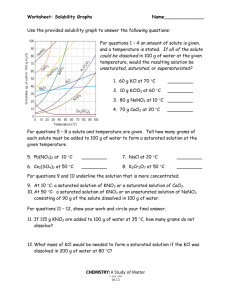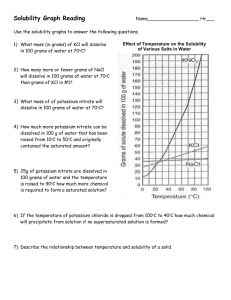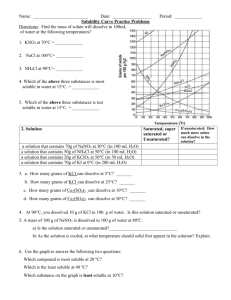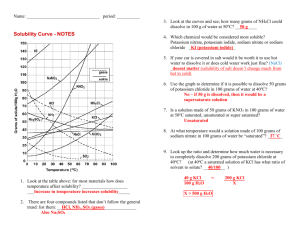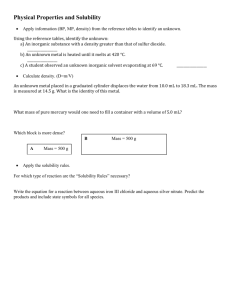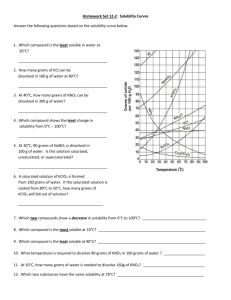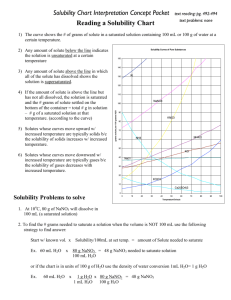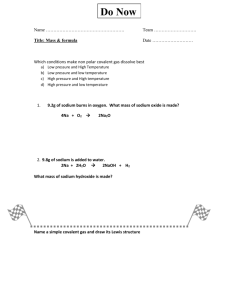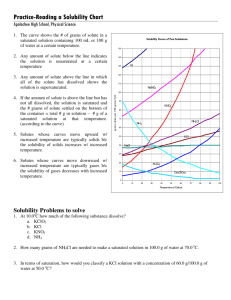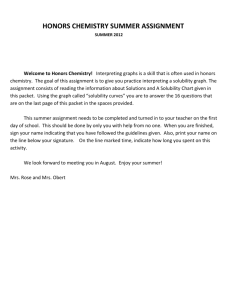Solutions, Solvation and Reading a Solubility Curve
advertisement
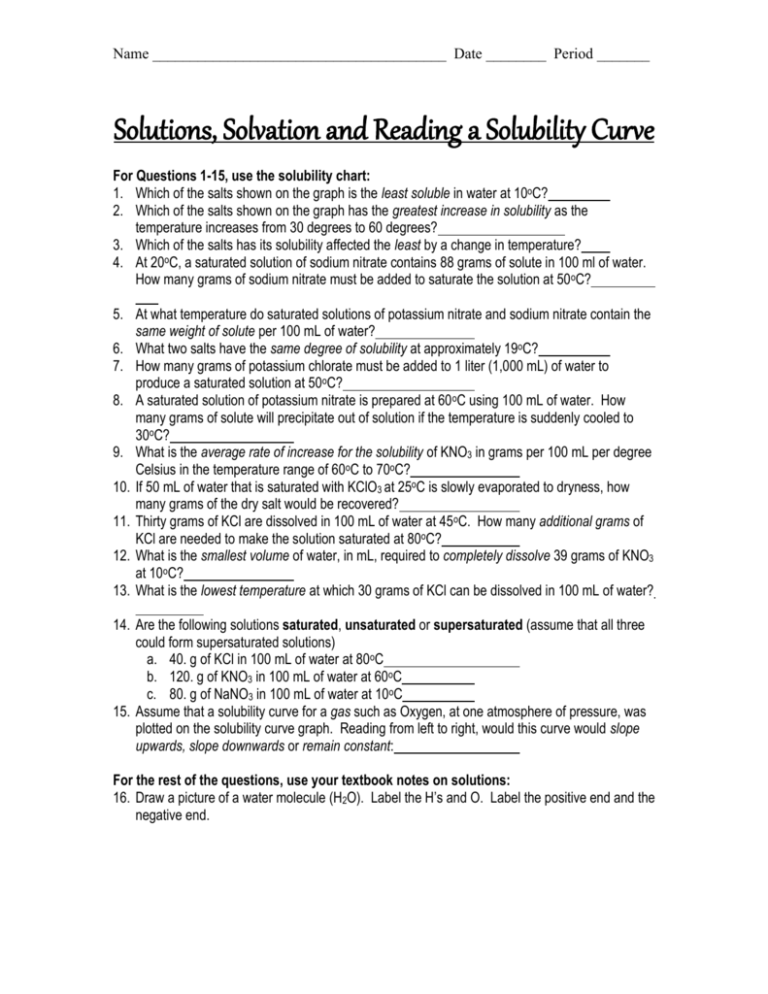
Name _______________________________________ Date ________ Period _______ Solutions, Solvation and Reading a Solubility Curve For Questions 1-15, use the solubility chart: 1. Which of the salts shown on the graph is the least soluble in water at 10oC? 2. Which of the salts shown on the graph has the greatest increase in solubility as the temperature increases from 30 degrees to 60 degrees? 3. Which of the salts has its solubility affected the least by a change in temperature? 4. At 20oC, a saturated solution of sodium nitrate contains 88 grams of solute in 100 ml of water. How many grams of sodium nitrate must be added to saturate the solution at 50oC? 5. At what temperature do saturated solutions of potassium nitrate and sodium nitrate contain the same weight of solute per 100 mL of water? 6. What two salts have the same degree of solubility at approximately 19oC? 7. How many grams of potassium chlorate must be added to 1 liter (1,000 mL) of water to produce a saturated solution at 50oC? 8. A saturated solution of potassium nitrate is prepared at 60 oC using 100 mL of water. How many grams of solute will precipitate out of solution if the temperature is suddenly cooled to 30oC? 9. What is the average rate of increase for the solubility of KNO3 in grams per 100 mL per degree Celsius in the temperature range of 60oC to 70oC? 10. If 50 mL of water that is saturated with KClO3 at 25oC is slowly evaporated to dryness, how many grams of the dry salt would be recovered? 11. Thirty grams of KCl are dissolved in 100 mL of water at 45oC. How many additional grams of KCl are needed to make the solution saturated at 80oC? 12. What is the smallest volume of water, in mL, required to completely dissolve 39 grams of KNO3 at 10oC? 13. What is the lowest temperature at which 30 grams of KCl can be dissolved in 100 mL of water? 14. Are the following solutions saturated, unsaturated or supersaturated (assume that all three could form supersaturated solutions) a. 40. g of KCl in 100 mL of water at 80oC b. 120. g of KNO3 in 100 mL of water at 60oC c. 80. g of NaNO3 in 100 mL of water at 10oC 15. Assume that a solubility curve for a gas such as Oxygen, at one atmosphere of pressure, was plotted on the solubility curve graph. Reading from left to right, would this curve would slope upwards, slope downwards or remain constant: For the rest of the questions, use your textbook notes on solutions: 16. Draw a picture of a water molecule (H2O). Label the H’s and O. Label the positive end and the negative end. Name _______________________________________ Date ________ Period _______ 17. From each pair below, select the water source more likely to contain the greater amount of dissolved nutrients (solids). Give a reason for each choice. a. A river with rapids or a quiet lake. _____________________________________________________________________ _____________________________________________________________________ b. A lake in spring or the same lake in summer. _____________________________________________________________________ _____________________________________________________________________ 18. From each pair below, select the water source more likely to contain the greater amount of dissolved oxygen (gas). Give a reason for each choice. a. A river with rapids or a quiet lake. _____________________________________________________________________ _____________________________________________________________________ b. A lake in spring or the same lake in summer. _____________________________________________________________________ _____________________________________________________________________ 19. Draw a picture showing how a crystal of LiBr would look when dissolved in water. Include: The ions and label them with their symbol and charge (ie. NaCl breaks into Na + and Cl-). Around each ion, draw at least three water molecules. Label the ends of the water molecule (+ and -) and make sure they are oriented correctly. 20. Draw a picture of what is happening to the molecules in a sugar cube as it dissolves. Include in your diagram a representation of the water molecules as well as the sugar molecules. 21. For each solution below, tell what is the solvent and what are the solutes. Solution Solvent Sugar water Salt water 10 ml alcohol in 100 ml water 10 ml CCl4 in 100 ml oil A scuba tank with 2 parts nitrogen to 1 part oxygen 14 carat gold (60% gold, 20% copper, 20% silver) Solute Name _______________________________________ Date ________ Period _______ 22. Is the substance in the picture to the right dissolving? Explain. 23. No, they are dissolving. The sandcastles are melting! They are both wrong. This is what is happening! _____________________ _____________________ _____________________ _____________________ ____________ 24. On the back of this paper draw the final frame for the following comic strip. You will not be graded on artistic ability, but rather the science involved. Your drawing should be neat. If you do not believe that someone could look at the frame and understand the science, you should label or add captions as needed. Captain I. Onic of the molecular submarine the BHS is thinking, “What a nice day to float around with these lazy water molecules, they aren’t even dissolving the salt very quickly, which is good for me, those Na+ ions do some real damage to the sub…” OH NO! A stirring rod!
